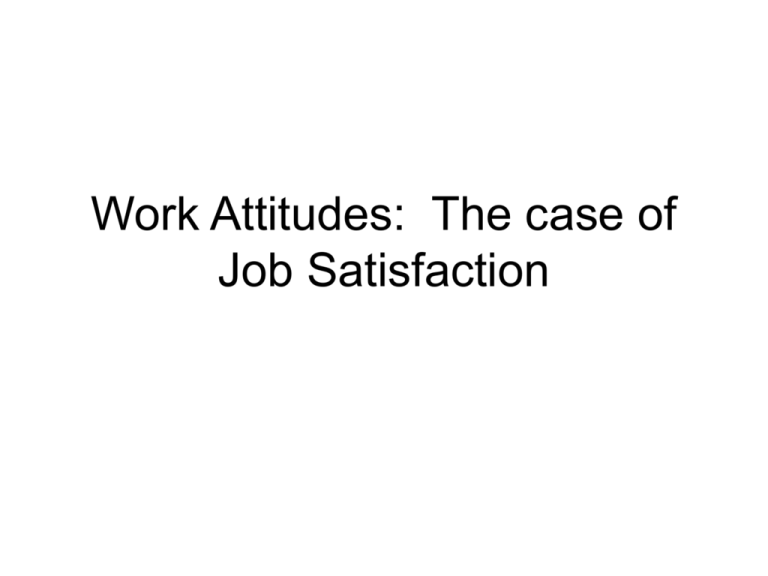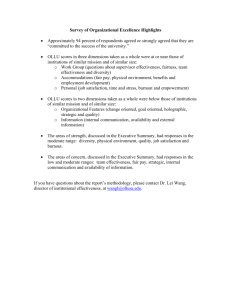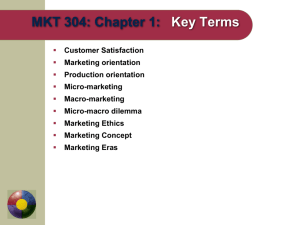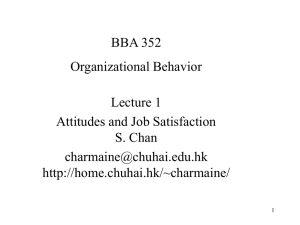
Work Attitudes: The case of
Job Satisfaction
Basic assumption
• The satisfied worker is a productive
worker. Therefore a supervisors job is
requires having a satisfied worker to
unleash their potential. Assumes which
leadership styles are best? Which style
does not really care about job satisfaction?
What is job satisfaction?
• Affective or emotional response to one’s
job.
• Highlight emotional. Normal fluctuations.
Why is the a leadership topic.
• Human relation school of thought.
Are you
• Very satisfied, satisfied, dissatisfied, or
very dissatisfied with your job.
• Why?
• Share in teams.
• Focus on the differences of why people
are satisfied and dissatisfied.
6-15
Correlates of Job Satisfaction
Variables Related to Job
Satisfaction
Direction of
Relationship
Strength of
Relationship
Motivation
Positive
Moderate
Organizational
citizenship behavior
Absenteeism
Positive
Moderate
Negative
Weak
Tardiness
Negative
Moderate
Withdrawal Cognitions
Negative
Strong
McGraw-Hill
Table 6-4
© 2004 The McGraw-Hill Companies, Inc. All rights reserved.
6-16
Table 6-4 cont.
Correlates of Job Satisfaction
Variables Related to Job
Satisfaction
Direction of
Relationship
Strength of
Relationship
Turnover
Negative
Moderate
Heart Disease
Negative
Moderate
Perceived Stress
Negative
Strong
Pro-union Voting
Negative
Moderate
Job performance
Positive
Moderate
McGraw-Hill
© 2004 The McGraw-Hill Companies, Inc. All rights reserved.
6-17
Table 6-4 cont.
Correlates of Job Satisfaction
Variables Related to Job
Satisfaction
Direction of
Relationship
Strength of
Relationship
Life satisfaction
Positive
Moderate
Mental health
Positive
Moderate
McGraw-Hill
© 2004 The McGraw-Hill Companies, Inc. All rights reserved.
6-18
Example of Direct Costs of Employee
Turnover
Table 6-5
Activity
Cost
Newspaper ads
$8,000
Search firm fees
$10,000
Interview costs
$4,000
Managerial time
$4,000
Work put on hold
$2,000
Overload on team
$4,000
McGraw-Hill
Training for new
employee
$6,000
© 2004 The McGraw-Hill Companies, Inc. All rights reserved.
Example of Direct Costs of
Employee Turnover
Activity
$8,000
Lowered office
morale
$2,000
Loss of other
employees
$3,000
Signing bonus &
other perks
$6,000
Relocation expense
$7,000
The Final Tab
Table 6-5 cont.
Cost
Lost contracts,
customers, and or
accounts
McGraw-Hill
6-19
$64,00
0
© 2004 The McGraw-Hill Companies, Inc. All rights reserved.
Ways to build job satisfaction
• Discrepancy models. Expectation levels
and expectation are exceeded satisfied or
not met dissatisfied. Goal orientation.
• Thus, Realistic job previews.
• Hedonic treadmill.
Values
• Work situation represents values that are
important to you. Person-organization fit,
person job fit.
GEs values
Passion for Our Customers: Measuring our success by that of our
customers...always driven by Six Sigma quality a spirit of innovation
– Meritocracy: Creating opportunities for the best people from around the world
to grow and live their dreams
– Growth Driven, Globally Oriented: Growing our people, markets and
businesses around the world
– Every Person, Every Idea Counts: Respecting the individual and valuing
contributions of each employee
– Playing Offense: Using the advantages of size to take risks and try new
things...never allowing size to be a disadvantage
– Embracing Speed and Excellence: Using the benefits of a digital age to
accelerate our success and build a faster and smarter GE
Culture of Target
• You are a person that will love our fun and
challenging work environment. You are a
performance-driven risk-taker and will be
encouraged to succeed. You appreciate
feedback because it contributes to your
professional development and growth. You
are part of a socially responsible
organization that gives more than $2
million a week to the communities it
serves.
Salesperson
• Autonomy
• Fast paced
• Results oriented
Procedural justice
• Informed of how resources were going to
be distributed.
• Similar opportunities for all to get
resources.
• Resources distributed in unbiased manner.
• If problems occur, right of grievance.
All can be relevant components to
job satisfaction.
•
•
•
•
Which is most important to you and why?
Outcomes goal orientation.
Values
Equity.
Challenges of non authority
compliance leaders.
• Try to match ways you can keep people
most satisfied. Equity driven organization.
• Strong values?
• Are leaders straight, clear and honest.
What to expect, when to expect it, how to
get it.






